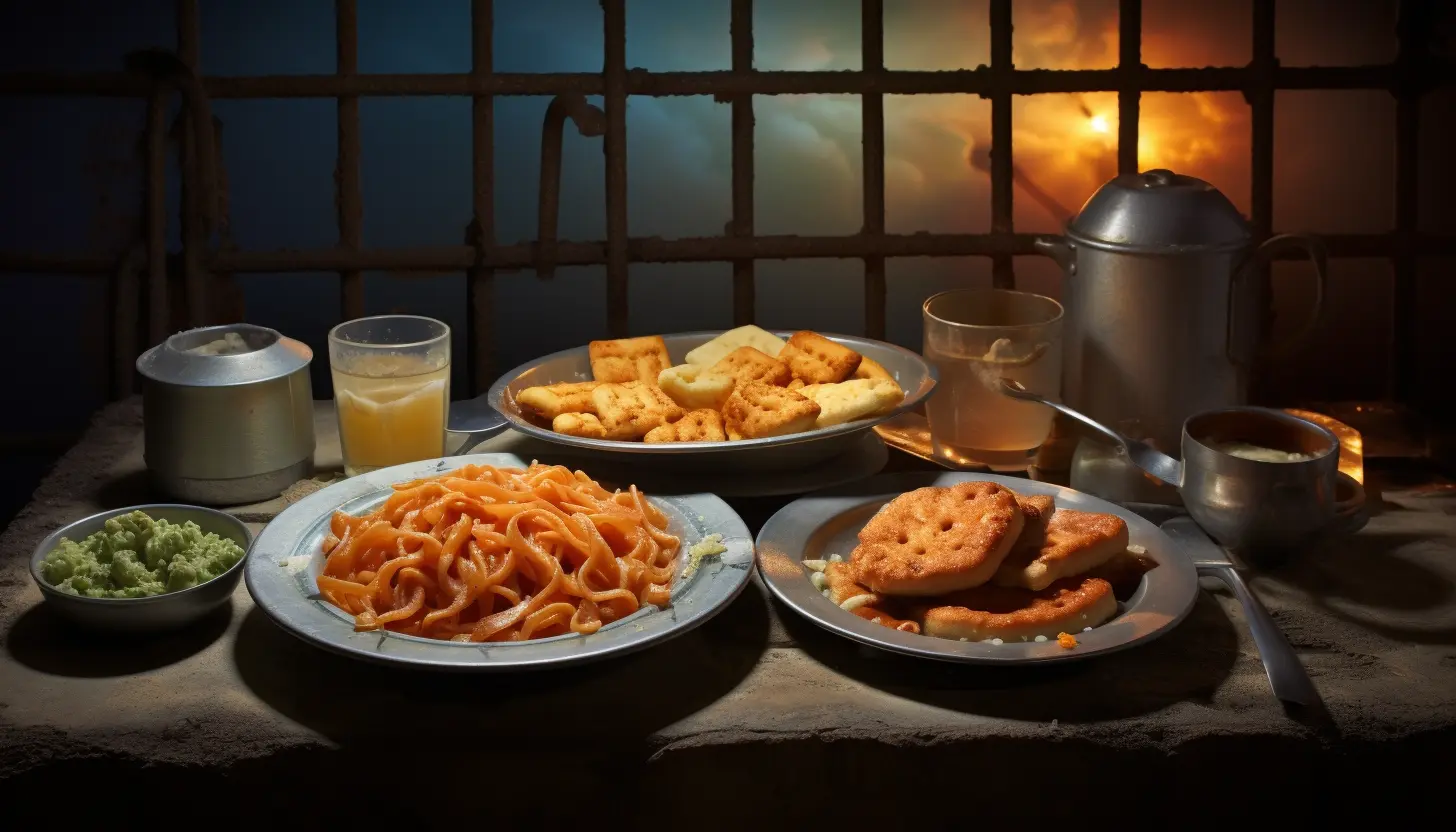Welcome to “The Ultimate Guide to Prison Food Recipes!” In this comprehensive blog post, we will embark on a journey into the often overlooked world of prison cuisine. While the topic of prison food may seem unconventional, understanding its significance is vital to gaining insight into the lives of inmates and the challenges they face.
Jump directly to the Prison Food Recipes
Behind the towering walls and barbed wire fences, food becomes a central aspect of an inmate’s daily life. In prison, food serves not only as sustenance but also as a means of comfort, a source of solace, and a reminder of the outside world. It can play a crucial role in an inmate’s physical and mental well-being, affecting their behavior, mood, and overall rehabilitation journey.
Correctional facilities present unique challenges when it comes to providing food for inmates. Limited budgets, stringent regulations, and the need to mass-produce meals can often result in bland and monotonous menus. However, there is a growing recognition of the importance of nutrition and taste in the rehabilitation process. By introducing healthier and more flavorful meal options, prisons can contribute to the overall well-being and successful reintegration of inmates into society.
In this guide, we will explore various aspects of prison food, diving deep into the culture, challenges, and potential for reform. We will provide insights into the typical prison food environment, examining the ingredients and techniques commonly used in prison cooking. By understanding the intricacies of this unique food culture, we can gain a deeper appreciation for the efforts made to provide nourishing meals within the constraints of a correctional facility.
Moreover, we will delve into the art of creating delicious and nutritious prison meals. From breakfast ideas to lunchtime favorites and dinner recipes that can elevate the prison dining experience, we will offer a range of recipes that can be prepared using limited resources. These recipes aim to not only satisfy hunger but also provide a sense of comfort and enjoyment in an otherwise challenging environment.
In addition to exploring the culinary aspect, we will discuss creative ways to make the most of the limited ingredients and resources available within a prison setting. By maximizing what is on hand and utilizing commissary items, inmates can enhance the flavor and variety of their meals. We will provide valuable tips and tricks for improvising with available ingredients and offer alternatives for cooking utensils and appliances.
No guide on prison food would be complete without acknowledging the success stories and the potential for reform. We will highlight examples of correctional facilities that have implemented innovative food programs with positive outcomes for inmates’ well-being and rehabilitation. These success stories will inspire us to advocate for prison food reform, addressing the need for improved nutrition and taste within correctional facilities. By exploring the role of activism and public support, we can drive change and ensure that inmates are provided with nourishing meals that contribute to their overall well-being.
Join us on this enlightening journey as we uncover the world of prison food recipes. Together, we can shed light on the significance of food in the rehabilitation process and work towards a future where every inmate is provided with nutritious and flavorful meals that contribute to their journey of transformation and reintegration. So, let’s dive in and explore the fascinating realm of prison cuisine!
Exploring Prison Food Culture
Within the confines of correctional facilities, a unique food culture emerges. The typical prison food environment is vastly different from the outside world, presenting a range of challenges and constraints that affect the quality and variety of meals provided to inmates.
In a correctional facility, the kitchen operates on a large scale, serving hundreds or even thousands of meals every day. This mass production setup requires streamlined processes and standardized recipes to ensure efficiency and consistency. Consequently, the focus often shifts towards quantity rather than quality, leading to meals that lack flavor and creativity.
The limited budget allocated for prison food further exacerbates the challenge. With tight financial constraints, correctional facilities must find ways to stretch their resources, resulting in a reliance on inexpensive and sometimes low-quality ingredients. This can lead to monotonous and repetitive menus that fail to provide the necessary nutrients and enjoyment for inmates.
In addition to budgetary constraints, strict regulations govern the procurement and preparation of prison meals. These regulations aim to maintain security and prevent the smuggling of contraband items. Consequently, certain ingredients and cooking methods may be restricted or prohibited, limiting the culinary possibilities within a correctional facility.
Despite these challenges, prison food culture has evolved through necessity and ingenuity. Inmates and kitchen staff have found ways to make the most of the available resources, often relying on creativity and improvisation. They have developed techniques to enhance the flavor of simple ingredients and create dishes that provide a sense of comfort and community within the prison walls.
Furthermore, the significance of food extends beyond physical sustenance in the correctional setting. Meals become a significant part of an inmate’s daily routine, providing a brief respite from the monotony of prison life. Sharing meals with fellow inmates can foster a sense of camaraderie and normalcy, promoting social interaction and a semblance of family-like bonds.
Understanding the nuances of prison food culture is crucial in developing recipes that are not only nutritious but also resonate with the inmates. By acknowledging the challenges faced by kitchen staff, we can appreciate the efforts made to provide nourishing meals within the limitations of a correctional facility. Moreover, recognizing the importance of shared meals in fostering a sense of community can inspire us to create recipes that promote a positive dining experience within the prison environment.
Creating Delicious and Nutritious Prison Meals
In the world of prison cuisine, the challenge lies not only in providing sustenance but also in creating meals that are both delicious and nutritious. In this section, we will explore how correctional facilities can incorporate nutritional guidelines into prison recipes and offer inmates satisfying meal options throughout the day.
Incorporating Nutritional Guidelines into Prison Recipes
Balanced meals are essential for the overall well-being of inmates. However, meeting nutritional guidelines within the constraints of a correctional facility can be a daunting task. It requires careful consideration of portion sizes, nutrient composition, and the availability of ingredients. By focusing on incorporating essential nutrients, correctional facilities can contribute to the physical health and rehabilitation of inmates.
When planning prison meals, it is important to consider the recommended calorie intake for inmates based on their age, sex, and activity level. A balanced diet should include a variety of macronutrients such as carbohydrates, proteins, and fats, as well as micronutrients like vitamins and minerals. By understanding these guidelines, kitchen staff can create recipes that meet the nutritional needs of inmates while working within the limitations of their resources.
Recipe Ideas for Breakfast in Prison
Breakfast is often considered the most important meal of the day, providing energy and setting the tone for the day ahead. In the prison environment, a satisfying and nutritious breakfast can make a significant difference in an inmate’s well-being. By incorporating simple ingredients and creative techniques, breakfast options can be elevated beyond the typical institutional fare.
One popular breakfast idea in a correctional facility is prison-style oatmeal. Made with just a few ingredients such as rolled oats, water, and a touch of sweetness, this recipe provides a warm and comforting start to the day. Inmates can also explore the option of homemade granola bars, packed with oats, nuts, and dried fruits, offering a portable and nutritious breakfast option.
Lunchtime Favorites for Inmates
Lunchtime presents an opportunity to provide inmates with a satisfying and flavorful meal that can help break the monotony of prison life. By incorporating diverse ingredients and spices, correctional facilities can offer lunch options that are both enjoyable and nutritious.
One lunchtime favorite is the DIY prison-style burrito. This versatile dish allows inmates to choose from a variety of fillings such as beans, rice, vegetables, and a protein source like grilled chicken or tofu. By providing a selection of fresh ingredients, inmates can customize their burritos to their liking, adding flavor and variety to their meal.
Another option for lunch is a vegetable stir-fry. By including a mix of colorful vegetables and a protein source such as tofu or lean meat, this dish offers a balance of nutrients and flavors. The stir-fry can be seasoned with spices and herbs, creating a satisfying and healthy lunch option for inmates.
Dinner Recipes to Elevate the Prison Dining Experience
Dinner is often the last meal of the day and an opportunity to provide inmates with a satisfying and comforting dining experience. By incorporating flavorful ingredients and cooking techniques, correctional facilities can elevate the dinner options beyond the standard fare.
One dinner recipe that can bring comfort to inmates is prison-style chili. Made with ground beef or turkey, beans, tomatoes, and a blend of spices, this hearty dish provides warmth and flavor. Inmates can savor the rich aroma and taste of the chili, bringing a sense of familiarity and satisfaction to their evening meal.
For a healthier dinner option, baked chicken with vegetables is a great choice. By marinating chicken in a flavorful sauce and roasting it alongside a medley of colorful vegetables, inmates can enjoy a well-rounded meal that is both nutritious and delicious. This recipe allows for creativity, as different spices and herbs can be used to enhance the flavor profile.
By offering a variety of breakfast, lunch, and dinner recipes, correctional facilities can provide inmates with meals that are not only nutritionally balanced but also satisfying to the palate. These recipes can bring a sense of normalcy and enjoyment to the prison dining experience, contributing to the overall well-being and rehabilitation of inmates.
Making the Most of Prison Food Resources
In the world of prison cuisine, making the most of limited ingredients and resources is a skill that inmates and kitchen staff must master. The constraints of a correctional facility require creativity and resourcefulness to enhance the flavor and variety of meals. In this section, we will explore ways to maximize the available resources and provide inmates with more satisfying and enjoyable dining experiences.
Maximizing Limited Ingredients and Tools
Working within the limitations of a correctional facility often means making do with what is available. Inmates and kitchen staff must find innovative ways to maximize the limited ingredients and tools at their disposal. This involves thinking outside the box and finding creative solutions to enhance the taste and presentation of meals.
One strategy is to focus on flavor enhancement through seasonings and spices. Even with limited ingredients, the right combination of herbs and spices can transform a simple dish into a flavorful masterpiece. By utilizing a variety of seasonings such as garlic powder, onion powder, cumin, and paprika, inmates can elevate the taste of their meals and add depth to their culinary creations.
Additionally, improvisation plays a crucial role in maximizing limited resources. In the absence of traditional cooking utensils, inmates can utilize alternative methods to prepare their meals. For instance, a plastic bag can be transformed into a makeshift piping bag for icing, or a metal mug can be used as a substitute for a mixing bowl. By thinking creatively and adapting to the available tools, inmates can overcome the challenges posed by limited resources.
Creative Ways to Use Commissary Items in Recipes
The commissary, a small store within the correctional facility, offers inmates access to a limited selection of additional food items. These commissary items can be incorporated into recipes to add variety and flavor to meals. Inmates often use these items to enhance the otherwise monotonous menu and create unique dishes.
One popular commissary item that is versatile and can be used in a multitude of recipes is ramen noodles. While ramen noodles are typically associated with a quick and easy meal, inmates have found ways to transform them into more elaborate creations. By adding vegetables, protein sources, and spices to the noodles, inmates can create a range of flavorful and satisfying dishes such as stir-fries or noodle soups.
Commissary items such as canned tuna, sardines, or chicken can also be used to add protein to various recipes. These ingredients can be incorporated into salads, sandwiches, or pasta dishes, providing inmates with additional nutrients and flavors.
By making the most of commissary items and utilizing them creatively, inmates can expand their culinary options and enhance the taste and variety of their meals.
Maximizing the available resources and utilizing commissary items creatively can significantly improve the dining experience within a correctional facility. By experimenting with flavors, improvising with tools, and incorporating additional ingredients, inmates can create meals that are both satisfying and enjoyable. These strategies empower inmates to take control of their culinary experiences and make the most of the resources at hand.
Prison Food Recipes
- Availability of Ingredients: Often, prisoners have limited access to fresh ingredients and may rely heavily on commissary items or basic staples provided in prison.
- Cooking Methods: Prisoners may not have access to a full kitchen. They might only have a microwave or hot water from a tap.
- Health and Nutrition: While ingredients may be limited, it’s still crucial to strive for balanced meals.
Here are some recipes that can be adapted to suit the constraints of a prison environment:
Instant Noodle Stir Fry
Ingredients: 1 packet of instant noodles 1 pouch of tuna or pre-cooked meat (if available) Dried vegetables (like peas or carrots) Soy sauce or any available sauce packets Spices: garlic powder, chili flakes (optional) Instructions: 1. Prepare the noodles as per the instructions, but don’t add the seasoning. 2. Drain the noodles and mix with the tuna or pre-cooked meat. 3. Rehydrate the dried vegetables with hot water. 4. Mix the vegetables, soy sauce, and spices with the noodles.
Microwave Burrito
Ingredients: Tortilla wraps Canned beans (like refried beans or black beans) Pre-packaged rice Cheese (if available) Salsa or hot sauce packets Instructions: 1. Spread beans and rice on the tortilla. 2. Add cheese and salsa or hot sauce. 3. Roll up the tortilla and microwave for 1-2 minutes.
Peanut Butter Energy Bites
Ingredients: 1 cup oats ½ cup peanut butter Honey or syrup packets Dried fruit or nuts (if available) Optional: powdered drink mix for flavor Instructions: 1. In a bowl, mix oats and peanut butter. 2. Add honey or syrup for sweetness. 3. Mix in dried fruit, nuts, or any optional ingredients. 4. Roll into small balls and refrigerate (if possible).
Spread
This is a popular prison dish, often made with whatever ingredients are available. Ingredients: 1 packet of instant noodles Canned meat or fish Cheese (like a cheese slice or spread) Crackers or chips Any available condiments (like mayo, ketchup, hot sauce) Instructions: 1. Cook the instant noodles and drain. 2. Crush crackers or chips into the noodles. 3. Mix in meat, cheese, and condiments. 4. Adjust seasoning using the noodle's seasoning packet.
Microwave Mug Cake
Ingredients: 4 tablespoons flour 4 tablespoons sugar 2 tablespoons cocoa powder 3 tablespoons milk or water 3 tablespoons vegetable oil or melted butter A pinch of salt Optional: chocolate chips or candies Instructions: 1. In a microwave-safe mug, mix all the ingredients. 2. Microwave for 1.5 to 2 minutes.
Chickpea Salad Sandwich
Ingredients: 1 can (15 oz) chickpeas, drained and rinsed 1/4 cup mayonnaise (or Greek yogurt for a healthier option) 1 tablespoon Dijon mustard 1/4 cup chopped celery 1/4 cup chopped red onion 2 tablespoons chopped fresh parsley Salt and pepper to taste Bread or lettuce wraps for serving Instructions: 1. In a bowl, mash the chickpeas until mostly smooth, but with some chunks remaining. 2. Stir in the mayonnaise, mustard, celery, red onion, and parsley. 3. Season with salt and pepper. 4. Serve on bread or in lettuce wraps.
Coconut Curry Lentil Soup
Ingredients: 1 cup dried lentils 1 onion, chopped 2 cloves garlic, minced 1 tablespoon curry powder 1 can (13.5 oz) coconut milk 4 cups vegetable broth Salt and pepper to taste 2 tablespoons coconut oil or vegetable oil Fresh cilantro for garnish Instructions: 1. In a pot, heat oil and sauté onions until translucent. 2. Add garlic and curry powder, cooking for another 2 minutes. 3. Add lentils, coconut milk, and vegetable broth. 4. Bring to a boil, then reduce heat and simmer for 25-30 minutes or until lentils are tender. 5. Season with salt and pepper. 6. Serve hot, garnished with fresh cilantro.
Spaghetti Aglio e Olio
Ingredients: 200g spaghetti 4 cloves garlic, thinly sliced 1/2 teaspoon red pepper flakes 1/4 cup olive oil Salt to taste Fresh parsley, chopped Grated Parmesan cheese (optional) Instructions: 1. Cook spaghetti according to package instructions until al dente. Reserve 1/4 cup pasta water. 2. In a pan, heat olive oil over medium heat. Add garlic and red pepper flakes, cooking until garlic is golden. 3. Add cooked spaghetti to the pan with a bit of reserved pasta water. Toss well. 4. Season with salt and toss with fresh parsley. 5. Serve with grated Parmesan if desired.
Banana Pancakes
Ingredients: 2 ripe bananas, mashed 2 eggs 1/4 teaspoon baking powder Butter or oil for cooking Maple syrup, berries, or yogurt for serving Instructions: 1. In a bowl, mix mashed bananas, eggs, and baking powder. 2. Heat a non-stick skillet with a bit of butter or oil. 3. Pour small ladles of the batter into the skillet, cooking until bubbles form on 4. the surface, then flip and cook the other side. 5. Serve with maple syrup, berries, or yogurt.
Chocolate Avocado Pudding
Ingredients: 2 ripe avocados 1/4 cup cocoa powder 1/4 cup honey or maple syrup 1 teaspoon vanilla extract A pinch of salt Instructions: 1. In a blender or food processor, blend all the ingredients until smooth. 2. Chill in the refrigerator for at least an hour before serving.
Conclusion: The Power of Food in Rehabilitation
Throughout this comprehensive guide, we have explored the intricacies of prison food, from its significance in the lives of inmates to the challenges faced by correctional facilities in providing nutritious and flavorful meals. We have delved into the culture of prison food, discovering the unique environment in which meals are prepared and consumed. Furthermore, we have shared recipes and strategies for creating delicious and satisfying prison meals, even with limited resources.
Food holds immense power, even within the confines of a correctional facility. It can shape an inmate’s physical and mental well-being, influencing behavior, mood, and overall rehabilitation. By recognizing the importance of nutrition and taste in prison food, we can contribute to the successful reintegration of inmates into society.
The success stories we have explored serve as beacons of hope, demonstrating that change is possible. Innovative programs and initiatives have shown that providing inmates with nutritious and flavorful meals can have a transformative impact. The San Francisco County Jail’s Garden Project and the Oregon Department of Corrections’ culinary program are just two examples of how inmate well-being can be improved through a focus on quality food and culinary education.
However, there is still much work to be done. Advocacy and activism play vital roles in driving prison food reform. By raising awareness, engaging with policymakers, and supporting initiatives that prioritize nutrition and taste, we can pave the way for a future where every inmate has access to meals that nourish both the body and the spirit.
Let us continue to support efforts that promote better prison food and advocate for change. By doing so, we can contribute to the rehabilitation process, foster positive behavior, and create an environment that values the well-being of inmates. Together, we can ensure that no one is left behind when it comes to access to nutritious and satisfying meals.
Food has the power to heal, to inspire, and to connect us all. Let us harness this power to create a brighter future for those within the correctional system. Through culinary creativity, compassion, and a commitment to reform, we can transform prison food into a force for positive change.










